Peru is a country of about five hundred thousand square miles (1.3m km²) and has just under thirty million inhabitants, one third of them residies in Lima, or around it (depending on where one cares to draw the city limits).
We docked in Callao, one of Lima’s forty-three districts and a busy port. It was six in the morning. The whole night the foghorn had been producing its basal noise, presumably with a frequency that was in some way proportional to the thickness of the fog – or the wakefulness of the bridge officers. (I bet it was the former).
The Humboldt Current, who causes this pea soup of sorts, glues the fog over thousands of miles to the coastline, stretching from well into Chile to the Southern shores of Ecuador (equivalent to a fog from Oslo to Lisbon, and potentially stretching all the way to Dublin in summer). Our guide would translate this in straight and simple English: Lima is a city where it never rains and where it is always foggy; therefore the sun shines “poco”. He added “unfortunately” to the statement, which would prove to be his favorite word during the entire day.
Three hundred years ago Lima must, in terms of architecture, have been a pearl of capital city. What is now called the “colonial town” holds the forlorn promise of class and riches. The classical Spanish baroque style is in abundant evidence, mimicking in every street something of the Plaza Mayor in Madrid, albeit embellished by the pure and varied palette of colors that reveal its profound “southern”-ness. The Plaza Mayor of Lima proper was occupied by hunger strikers, including their cardboard squats and babies to boost, who were demanding (at least) work. From closer range the buildings looked in obvious decline, and many in disrepair. That started in the eighties, and our guide added that the area was dangerous at night, unfortunately.
 The neo-classical part of Lima is, in a less cozy but more monumental way, just as impressive. And it is well kept. That has everything to do with the simple fact that it is the place where the current powers hold office: the presidential palace, the mayoral palace, the “social club of Lima”, the cathedral and Episcopal Palace, the Franciscan Monastery, the headquarters of the banks, as well as related institutes and institutions. The parks, filled with perennial rainbows of blossoming flowers, give it all a relaxed and pleasant atmosphere.
The neo-classical part of Lima is, in a less cozy but more monumental way, just as impressive. And it is well kept. That has everything to do with the simple fact that it is the place where the current powers hold office: the presidential palace, the mayoral palace, the “social club of Lima”, the cathedral and Episcopal Palace, the Franciscan Monastery, the headquarters of the banks, as well as related institutes and institutions. The parks, filled with perennial rainbows of blossoming flowers, give it all a relaxed and pleasant atmosphere.
It is safe too, a feature helped along by four kinds of police: the tourist police, the traffic police, the security guards and the military-like police. In front of the presidential palace that array of protection is further complemented by the ceremonial guards, as well as by Special Forces (with impressive firepower). Peruvians want to make sure that their President is truly safe, and this central square is appropriately called “Plaza de Armas”.
In terms of living comfort, Lima can actually be summarily categorized as four different cities. The smallest is the official Lima, described above. The second smallest is the rich Lima, occupying a nice stretch of ocean front, and sporting all the luxury hotels, designer stores, fine restaurants, .. all the modern works! Furthermore there is the poor Lima and the poorest Lima. I have no way of knowing which one of the latter is the “biggest” but surmise that the favela’s, hanging off the hillsides (much like in Rio) are tops in numbers. These numbers keep growing fast, naturally as well as through “immigration”, unfortunately. Noteworthy is that, in the poor Lima, the “less poor” (perhaps the well-off) secure their public streets at night by means of a steel gate.
 The average annual GDP per head is five thousand dollars. (By the way, this compares with a salary of eight thousand dollars per month for one of Lima’s district mayors or any member of parliament). Thirty-six percent of Peruvians live below the (Peruvian) poverty line; twelve percent are labeled “extremely poor”. Estimates put the number of poor people in Lima province at 75%, unfortunately.
The average annual GDP per head is five thousand dollars. (By the way, this compares with a salary of eight thousand dollars per month for one of Lima’s district mayors or any member of parliament). Thirty-six percent of Peruvians live below the (Peruvian) poverty line; twelve percent are labeled “extremely poor”. Estimates put the number of poor people in Lima province at 75%, unfortunately.
Effective health care is out of reach for most, certainly for those without a job, even if temporary! Even official burial can be a stretch. Education till sixteen is mandatory and, in the city proper, logistically possible, but higher education is, notwithstanding admission exams (the next ones are advertized country-wide on billboards for March 27th), only attainable for the rich (private universities, expensive) and for the well-connected (public schools, for free). The academically best students rarely make it to university, unfortunately.
Let me try and summarize the spirit of this country by what I witnessed at the Franciscan Church on Monday, February 28th. We had been visiting the 16th century Monastery, founded by the priest that accompanied Pizarro when he killed Atahualpa, the last Inca emperor, I believe. Exiting from the well-kept monastery, I entered the attached church where, surprisingly on a Monday morning at eleven, there was a mass in “full swing”. The church was filled with kneeling people in the center, and a spate of ostentatiously praying believers in the aisles.
It was very quiet though, as the Consecration was in progress. I stood still myself, in deference for all this devotion. After they prayed “Our Father” – in real Spanish, which was a reprieve from all the other deviating idioms that I had heard until now – they wished one another “peace”; this is one of the more recent, worldwide innovations in the rite. As I left the church, I could not avoid thinking that, where poverty reigns, keeping the peace must be a priority. (Remember Egypt?!)
Outside of the building a long, long queue of people had formed, stretching for hundreds of yards. They were mostly women and children, all holding bouquets of colorful flowers. Flowers are cheap in Lima, they grow everywhere. But why are all these people here, and on a Monday? I asked the guide. Well, he replied, on the 28th of every month there is a special mass in this church in honor of San Juan from Somewhere (I forgot from where). That man is the patron saint for the “Lost Causes”, for those that are at their wit’s end, in utter despair, unfortunately. Although I was utterly stunned, I understood the logic: if there is nothing else to hope for, one can always offer a few flowers to gain the favor of a saint, every month again or, perhaps, only once a month. And in October they celebrate the big mass, to thank the saint for all the good deeds. It comes across as cynical, and I think it is, just as our guide sounded, unfortunately.
To be sure, Charles Darwin tells, mutatis mutandis, by and large a similar story about Lima and Peru in his travels on the Beagle. Moreover, he visited the land just after the revolution and the independence, which are times, one would think, that are full of energy and optimism. If those were still present at all then, they definitely were canalized by the military, the landlords (fundadores) and the church in the ensuing and unending power struggles. Darwin described Peru as the most depressing country of the continent. I agree, so far.
If you add the recent history into the picture, Peru made the greatest strides towards daily normalcy (eradication of the gruesome Shining Path guerilla)and economic growth during the presidency of Fujimori, from 1990 till 2000. He was a democratically elected president (who, no doubt, intended to change the constitution to get elected for another term). Today he is in jail in Peru, charged with corruption, authoritarianism and human rights abuses. I cannot pass judgment on his alleged crimes but I am unequivocally convinced that there are no other “powers” (be they oligarchy, military or church) in this dirt poor country that are free of those same (capital) sins.
Peru is, in the end, a very cynical country, from top layers to bottom strata, albeit in different ways, unfortunately. With new presidential elections coming soon, I will have to hurry to re-read Vargas Llosa’s “El Pez en el Agua” to appreciate better what I have witnessed here during these three short days.
Prinsendam, Day 58 – Thursday March 3rd, 2011
En route to the northern hemisphere, after one more southern stop
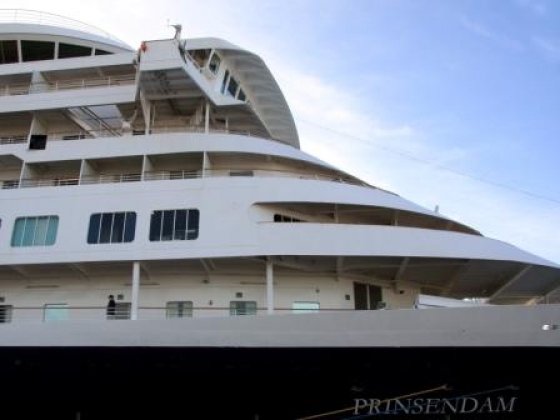
 Ontegensprekelijk zijn Antarctica en Amazonas zonder concurrent in de galerij van unieke ervaringen, waarbij ik de laatste als een ontdekkingsreis naar een soort oorsprong van menselijk leven zie, en de eerste als een onderdompeling in vervlogen geologische tijden. In die zin is het ook geen competitie van a tegen b, ze zijn immers onvergelijkbaar, allebei “buiten categorie”. Terugblikkend op Antarctica heb ik ook vandaag nog het gevoel van een vijandige omgeving, terwijl de Amazone rivier een uitnodigende geborgenheid als echo achterlaat.
Ontegensprekelijk zijn Antarctica en Amazonas zonder concurrent in de galerij van unieke ervaringen, waarbij ik de laatste als een ontdekkingsreis naar een soort oorsprong van menselijk leven zie, en de eerste als een onderdompeling in vervlogen geologische tijden. In die zin is het ook geen competitie van a tegen b, ze zijn immers onvergelijkbaar, allebei “buiten categorie”. Terugblikkend op Antarctica heb ik ook vandaag nog het gevoel van een vijandige omgeving, terwijl de Amazone rivier een uitnodigende geborgenheid als echo achterlaat. Het tweede boek is “Self comes to Mind: Constructing the Conscious Brain”” van Antonio Damasio, een wereldberoemd neuroloog en tevens expliciet “supporter” van Spinoza en van Darwin. Met zijn dertig jarige carrière in hersenonderzoek betreffende alles wat te maken heeft met oorsprong van gevoelens (versus pure emoties), is hij sinds jaren een toonaangevende autoriteit op het vlak van onderzoek naar begin en wezen van menselijk (en dierlijk) bewustzijn, en naar ons eigen bewustzijn van onszelf. Hij is niet alleen uitzonderlijk beslagen op zijn vakgebied, maar kan het ook op boeiende en meeslepende manier brengen.
Het tweede boek is “Self comes to Mind: Constructing the Conscious Brain”” van Antonio Damasio, een wereldberoemd neuroloog en tevens expliciet “supporter” van Spinoza en van Darwin. Met zijn dertig jarige carrière in hersenonderzoek betreffende alles wat te maken heeft met oorsprong van gevoelens (versus pure emoties), is hij sinds jaren een toonaangevende autoriteit op het vlak van onderzoek naar begin en wezen van menselijk (en dierlijk) bewustzijn, en naar ons eigen bewustzijn van onszelf. Hij is niet alleen uitzonderlijk beslagen op zijn vakgebied, maar kan het ook op boeiende en meeslepende manier brengen.  Our brochure advertized the Natural Bridge, the California Lighthouse and the Casibari Rock formations as must-see. I decide to jump in a taxi and do some quick reconnaissance (because I also had to start planning the last laundry and the early packing). The taxi driver informed me that the 25ft high stone bridge had collapsed in2005. The Lighthouse was closed to the public two years ago, because it had been abused for jumping off. (He added that the suicidal people now just step in the waters off the East coast of the island, and the currents and surf do the rest). That leaves the rocks … they are also 25ft high and cannot collapse because they are lying on the ground! Nobody knows by whom, and why, how or when they were collocated in that little area. I climbed them and discovered their only obvious value: you had a clear 360° view of the grounds, all two hundred square miles of them, almost featureless.
Our brochure advertized the Natural Bridge, the California Lighthouse and the Casibari Rock formations as must-see. I decide to jump in a taxi and do some quick reconnaissance (because I also had to start planning the last laundry and the early packing). The taxi driver informed me that the 25ft high stone bridge had collapsed in2005. The Lighthouse was closed to the public two years ago, because it had been abused for jumping off. (He added that the suicidal people now just step in the waters off the East coast of the island, and the currents and surf do the rest). That leaves the rocks … they are also 25ft high and cannot collapse because they are lying on the ground! Nobody knows by whom, and why, how or when they were collocated in that little area. I climbed them and discovered their only obvious value: you had a clear 360° view of the grounds, all two hundred square miles of them, almost featureless.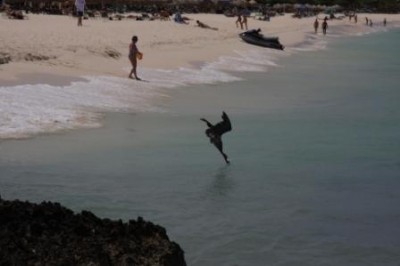 The afternoon was dedicated to training and packing. I say training because folding dress shirts, regular shirts, T-shirts and polo-shirts, in a way deemed acceptable when they arrive home, requires some practice. Meanwhile I noticed a continuous stream of big tankers moving East to West, and others West to East, along the horizon. I guess that it was oil from Chavez for his friends in Cuba. The world is a busy place indeed, also on the infinite oceans.
The afternoon was dedicated to training and packing. I say training because folding dress shirts, regular shirts, T-shirts and polo-shirts, in a way deemed acceptable when they arrive home, requires some practice. Meanwhile I noticed a continuous stream of big tankers moving East to West, and others West to East, along the horizon. I guess that it was oil from Chavez for his friends in Cuba. The world is a busy place indeed, also on the infinite oceans.
 Zoals reed aangegeven heb ik vanmorgen een taxi genomen om “à la carte” het eiland te herkennen. Op die kaart staan, volgens onze eigen dagelijkse gazet, drie gerechten: de California vuurtoren, de Casibari Rocks en de Natural Bridge. Die laatste, een acht meter hoge granieten boog over een kleine baai was vijf jaar geleden ingestort, meldde mijn lokale expert, met begrafenisogen. In Casibari werden een hoop rotsen, heel lang geleden, bij elkaar gelegd. Niemand weet waarom en door wie of door wat (een vulkaan?). Los van het feit dat je boven op de ronde top een 360 graden zicht hebt over het eiland, is het een afknapper.
Zoals reed aangegeven heb ik vanmorgen een taxi genomen om “à la carte” het eiland te herkennen. Op die kaart staan, volgens onze eigen dagelijkse gazet, drie gerechten: de California vuurtoren, de Casibari Rocks en de Natural Bridge. Die laatste, een acht meter hoge granieten boog over een kleine baai was vijf jaar geleden ingestort, meldde mijn lokale expert, met begrafenisogen. In Casibari werden een hoop rotsen, heel lang geleden, bij elkaar gelegd. Niemand weet waarom en door wie of door wat (een vulkaan?). Los van het feit dat je boven op de ronde top een 360 graden zicht hebt over het eiland, is het een afknapper. 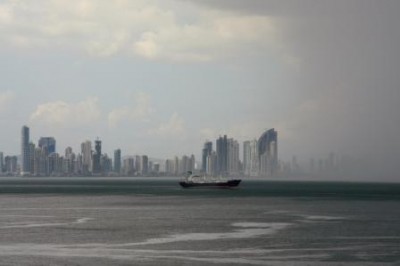 Yet, there are still seven indigenous tribes living in the rain forests of Panama, five in the East and two in the West. The readers, who like me, see Panama as split by the canal in North (Costa Rica) and South (Colombia) parts, better think of North as West and of South as East, as the Panamanians do. The trip started off with a bus ride of one hour, along a highway which was in a better state than the sound system on the bus. To make matters worse it looked as if the hearing impaired were sitting in the back, such that the front sitters started complaining when the guide turned up the decibels. Switching places would obviously have been an effective solution, were it not for the fact that the less mobile were also in the back of the bus …
Yet, there are still seven indigenous tribes living in the rain forests of Panama, five in the East and two in the West. The readers, who like me, see Panama as split by the canal in North (Costa Rica) and South (Colombia) parts, better think of North as West and of South as East, as the Panamanians do. The trip started off with a bus ride of one hour, along a highway which was in a better state than the sound system on the bus. To make matters worse it looked as if the hearing impaired were sitting in the back, such that the front sitters started complaining when the guide turned up the decibels. Switching places would obviously have been an effective solution, were it not for the fact that the less mobile were also in the back of the bus … 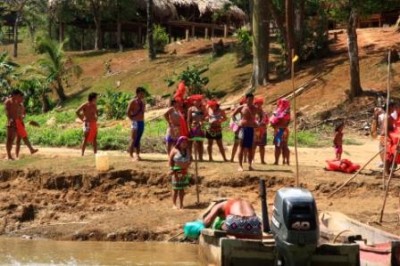 Nowhere was there any hint that they had (to) put up a show. We could see where they live, we could take pictures (not in the private dwellings), they explained (in Spanish) what they do and how they do it (a standard 20ft canoe is two months of hard work for seven able bodies), we could buy their artifacts of course, and nobody was begging. Although the villages of the Embera are isolated, allowing them to continue to adhere to culture and language, they are certainly not living in the wild. It was all relaxed, pleasant and instructive. I was lucky to bump into a resident (Greek) anthropologist as well; he explained how democratic and socially caring they all are where it comes to tribal affairs.
Nowhere was there any hint that they had (to) put up a show. We could see where they live, we could take pictures (not in the private dwellings), they explained (in Spanish) what they do and how they do it (a standard 20ft canoe is two months of hard work for seven able bodies), we could buy their artifacts of course, and nobody was begging. Although the villages of the Embera are isolated, allowing them to continue to adhere to culture and language, they are certainly not living in the wild. It was all relaxed, pleasant and instructive. I was lucky to bump into a resident (Greek) anthropologist as well; he explained how democratic and socially caring they all are where it comes to tribal affairs.  Niet dus. Eigenlijk was ik van plan om vandaag een beetje terug te blikken, alvorens ik morgen in het Koninkrijk Nederland arriveer. Inmiddels heeft men er mij attent op gemaakt dat er wel het één en ander aan praktische organisatie voor de “debarcation” ofte ontscheping te regelen valt. Het toeval wil – of misschien juist niet – dat ik onderweg van een goede vriend een e-mail had ontvangen die zich m.i. leent als voorbeschouwing, en op die manier enkele van de thema’s aansnijdt die ik sowieso had weerhouden. De auteur van dit verhaaltje is mij onbekend, maar hij zal deze publicatie zeker op prijs stellen.
Niet dus. Eigenlijk was ik van plan om vandaag een beetje terug te blikken, alvorens ik morgen in het Koninkrijk Nederland arriveer. Inmiddels heeft men er mij attent op gemaakt dat er wel het één en ander aan praktische organisatie voor de “debarcation” ofte ontscheping te regelen valt. Het toeval wil – of misschien juist niet – dat ik onderweg van een goede vriend een e-mail had ontvangen die zich m.i. leent als voorbeschouwing, en op die manier enkele van de thema’s aansnijdt die ik sowieso had weerhouden. De auteur van dit verhaaltje is mij onbekend, maar hij zal deze publicatie zeker op prijs stellen. Nederigheid siert de mens. Om te beginnen had ik nog nooit zoveel locomotieven op een rij gezien (op 2×2=4 rijen in feite). Dat die mastodonten vanop de kade de schepen voorttrokken en ze tegelijk met nauwkeurig manoeuvreren in het midden van de sluis hielden, door middel van een (computerondersteund?) trekkabelsysteem, was ook nieuw. Het meest verbazend vond ik dat die locomotieven – zij rijden op een tandradspoor, enkele meters verwijderend van de rand – nog nooit door een schip in het water waren gesleurd. Ongetwijfeld is daar hogere wiskunde of sterke lijm mee gemoeid, ook al dateert die van 1900.
Nederigheid siert de mens. Om te beginnen had ik nog nooit zoveel locomotieven op een rij gezien (op 2×2=4 rijen in feite). Dat die mastodonten vanop de kade de schepen voorttrokken en ze tegelijk met nauwkeurig manoeuvreren in het midden van de sluis hielden, door middel van een (computerondersteund?) trekkabelsysteem, was ook nieuw. Het meest verbazend vond ik dat die locomotieven – zij rijden op een tandradspoor, enkele meters verwijderend van de rand – nog nooit door een schip in het water waren gesleurd. Ongetwijfeld is daar hogere wiskunde of sterke lijm mee gemoeid, ook al dateert die van 1900.  Eigenlijk is dit gebied overstroomd regenwoud geworden, en de eilanden zijn de hogere heuvels van voorheen. Het grootste van deze eilanden heeft, dixit de expert op de brug, meer boomspecies dan gans West-Europa samen. Dat is iets wat mij niet is opgevallen (sic). Wat me wel aansprak was dat de tocht over het meer een beetje een Amazonegevoel gaf: overal water en groene bomen, en altijd vogels. Het grote verschil was de kleur: in het Gatun Meer waren het variaties op groen, terwijl de Amazone variaties op bruin creëerde. Een flashback die op dit moment al geschiedenis is geworden.
Eigenlijk is dit gebied overstroomd regenwoud geworden, en de eilanden zijn de hogere heuvels van voorheen. Het grootste van deze eilanden heeft, dixit de expert op de brug, meer boomspecies dan gans West-Europa samen. Dat is iets wat mij niet is opgevallen (sic). Wat me wel aansprak was dat de tocht over het meer een beetje een Amazonegevoel gaf: overal water en groene bomen, en altijd vogels. Het grote verschil was de kleur: in het Gatun Meer waren het variaties op groen, terwijl de Amazone variaties op bruin creëerde. Een flashback die op dit moment al geschiedenis is geworden.  In de Caribische Zee staat een verfrissende Atlantische wind. Het is gedaan met de zware warmte van dat evenaarsgebied langs de verkeerde kant van thuis! Ik ruik de Noordzee.
In de Caribische Zee staat een verfrissende Atlantische wind. Het is gedaan met de zware warmte van dat evenaarsgebied langs de verkeerde kant van thuis! Ik ruik de Noordzee. Het zicht op Panama City in de rijzende zon is de moeite waard. Als je zonder voorgaande reflectie ineens Panama City voor je ziet liggen dan schrik je wel effen – enfin, ik toch. Inderdaad, op één of andere manier beeld je je een stad in met wat hoge appartementsblokken en een resem “bel etage”-achtige optrekjes, in parallelle rijen naast, en boven of acher elkaar. Dat is trouwens de standaard manier van Spaanse stedenbouw, naar het illustere voorbeeld van Madrid. Welnu, Panama City heeft meer gemeen met Manhattan of Miami, dan met een grote Spaanse stad: wolkenkrabbers sieren de kuststrook, en laagbouw is ogenschijnlijk afwezig.
Het zicht op Panama City in de rijzende zon is de moeite waard. Als je zonder voorgaande reflectie ineens Panama City voor je ziet liggen dan schrik je wel effen – enfin, ik toch. Inderdaad, op één of andere manier beeld je je een stad in met wat hoge appartementsblokken en een resem “bel etage”-achtige optrekjes, in parallelle rijen naast, en boven of acher elkaar. Dat is trouwens de standaard manier van Spaanse stedenbouw, naar het illustere voorbeeld van Madrid. Welnu, Panama City heeft meer gemeen met Manhattan of Miami, dan met een grote Spaanse stad: wolkenkrabbers sieren de kuststrook, en laagbouw is ogenschijnlijk afwezig. De boot voor de tweede etappe bleek een kano te zijn. Hoewel hij voorzien was van een 40Hp Suzuki buitenboordmotor, was hij smal en “beweeglijk”, vooral rond zijn lengteas. Ik kan de lezers verzekeren dat het niet makkelijk is om met twee stokken en twee benen een achttal tweezitbanken (een plank over de breedte van de kano), en slecht horen maakt het er niet makkelijker op. Volgens de brochure was dit een tocht van een half uur over de rivier Rio Chagres. Welnu, ten eerste bleek die rivier eerst een groot meer te zijn (gemaakt als drinkwater reservoir bij de bouw van het Panama Kanaal) en ten tweede duurde die tocht een uur, daarin tien minuten meegerekend voor een “overtankbeurt” aangezien wij zonder brandstof waren gevallen.
De boot voor de tweede etappe bleek een kano te zijn. Hoewel hij voorzien was van een 40Hp Suzuki buitenboordmotor, was hij smal en “beweeglijk”, vooral rond zijn lengteas. Ik kan de lezers verzekeren dat het niet makkelijk is om met twee stokken en twee benen een achttal tweezitbanken (een plank over de breedte van de kano), en slecht horen maakt het er niet makkelijker op. Volgens de brochure was dit een tocht van een half uur over de rivier Rio Chagres. Welnu, ten eerste bleek die rivier eerst een groot meer te zijn (gemaakt als drinkwater reservoir bij de bouw van het Panama Kanaal) en ten tweede duurde die tocht een uur, daarin tien minuten meegerekend voor een “overtankbeurt” aangezien wij zonder brandstof waren gevallen. 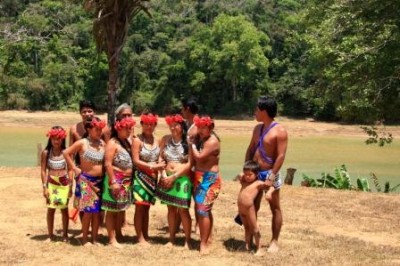 Omdat dit stukje anders te lang uitloopt en het morgen Rosenmontag is, zal ik het hierbij laten, echter niet zonder iets te zeggen over de terugtocht. Karnaval in Panama is natuurlijk drinken en dansen, zoals overal, maar heel specifiek wordt er te en te onpas met water gegooid. Welnu, de kanotocht terug was tegen de wind in … na een vijftal minuten werd de rivier terug een meer. De volgende twintig minuten heeft het water gegutst van jewelste, niet vanuit de hemel maar vanaf de kiel. Niettegenstaande mijn inderhaast uitgepakte plastieke poncho, die ik als “schild” gebruikte, was ik drijfnat aan armen en benen. Zo heb ik een stukje Panamees karnaval ondergaan!
Omdat dit stukje anders te lang uitloopt en het morgen Rosenmontag is, zal ik het hierbij laten, echter niet zonder iets te zeggen over de terugtocht. Karnaval in Panama is natuurlijk drinken en dansen, zoals overal, maar heel specifiek wordt er te en te onpas met water gegooid. Welnu, de kanotocht terug was tegen de wind in … na een vijftal minuten werd de rivier terug een meer. De volgende twintig minuten heeft het water gegutst van jewelste, niet vanuit de hemel maar vanaf de kiel. Niettegenstaande mijn inderhaast uitgepakte plastieke poncho, die ik als “schild” gebruikte, was ik drijfnat aan armen en benen. Zo heb ik een stukje Panamees karnaval ondergaan! I mention the latter only because I had firsthand experience with it. Indeed, we flew from Manta, where we were docked, to Quito in the early morning; clockwork orange, in a brand new A319, with free snacks and coffee. The return flight was a different story though. Our flight was “in suspense” because the Control Tower in Manta had experienced catastrophic failure, whatever that may mean. Eventually, we were rerouted to the “old, small airport”. A 30-seat Dornier 328 propjet – my maiden flight – brought us back to the old and small airport just before scheduled sailing time.
I mention the latter only because I had firsthand experience with it. Indeed, we flew from Manta, where we were docked, to Quito in the early morning; clockwork orange, in a brand new A319, with free snacks and coffee. The return flight was a different story though. Our flight was “in suspense” because the Control Tower in Manta had experienced catastrophic failure, whatever that may mean. Eventually, we were rerouted to the “old, small airport”. A 30-seat Dornier 328 propjet – my maiden flight – brought us back to the old and small airport just before scheduled sailing time.
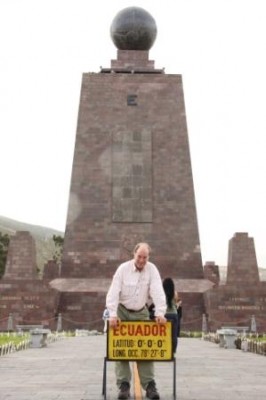 Of course, I also went to “La Mitad del Mundo”, the place at opposite ends of the continent from Macapà, in Brazil. Actually, it is here that (primarily) French scientist made the first exact scientific measurements about the earth’s equator. And, of course, I had my picture taken with one leg in the Northern and one in the Southern Hemisphere, simultaneously! The journey (journée) in Ecuador was a welcome reprieve from the choc of Peru: diversity and energy, both figuratively and literally. And there was lots of joy on the streets – Carnival is around the corner, as well!
Of course, I also went to “La Mitad del Mundo”, the place at opposite ends of the continent from Macapà, in Brazil. Actually, it is here that (primarily) French scientist made the first exact scientific measurements about the earth’s equator. And, of course, I had my picture taken with one leg in the Northern and one in the Southern Hemisphere, simultaneously! The journey (journée) in Ecuador was a welcome reprieve from the choc of Peru: diversity and energy, both figuratively and literally. And there was lots of joy on the streets – Carnival is around the corner, as well! Blijkbaar wordt die diversiteit, waarbij ook specialisatie in beroepen hoort, ervaren als een rijkdom. Los van de paar resterende afgezonderde stammen in het oostelijk oerwoudgebied, is de katholieke kerk, door de eeuwen heen, een bindende kracht geweest die wellicht de basis heeft gevormd voor een soort van universeel Ecuadoriaans rechtvaardigheidsgevoel. Wat betreft “de kerk” zal ik daar geen verder commentaar aan toevoegen behalve dat ik, onnoemelijk veel kerken in de wereld bezocht hebbende, geen enkele, maar dan ook geen enkele kerk heb gezien die zo ontzaglijk veel goud aan muren, pilaren, altaren en plafonds heeft hangen, staan of plakken als de Jezuïtenkerk van Quito.
Blijkbaar wordt die diversiteit, waarbij ook specialisatie in beroepen hoort, ervaren als een rijkdom. Los van de paar resterende afgezonderde stammen in het oostelijk oerwoudgebied, is de katholieke kerk, door de eeuwen heen, een bindende kracht geweest die wellicht de basis heeft gevormd voor een soort van universeel Ecuadoriaans rechtvaardigheidsgevoel. Wat betreft “de kerk” zal ik daar geen verder commentaar aan toevoegen behalve dat ik, onnoemelijk veel kerken in de wereld bezocht hebbende, geen enkele, maar dan ook geen enkele kerk heb gezien die zo ontzaglijk veel goud aan muren, pilaren, altaren en plafonds heeft hangen, staan of plakken als de Jezuïtenkerk van Quito.  Hoewel ik er slechts een klein stukje van heb gezien, denk ik dat Ecuador in zijn geheel een prachtig en vooral boeiend land is, waarbij je als bezoeker een veelheid van interessante fenomenen tegenkomt. Het landschap – ook vanuit de lucht – ziet er enig én verrukkelijk uit. Zelfs in Quito is de verscheidenheid van mensen en klederdrachten opvallend; over het algemeen hangt er een positieve en luchtige sfeer – er is ambiance. Ik heb me laten vertellen dat de provincie Chimborazo ( waar ook de hoogste berg van de wereld staat, gemeten vanaf het centrum van de aarde!) een dertigtal dorpen telt, naar Zuid-Amerikaanse normen wellicht allemaal even groot in oppervlakte als de provincie Brabant, waarvan de inwoners zich telkens anders kleren.
Hoewel ik er slechts een klein stukje van heb gezien, denk ik dat Ecuador in zijn geheel een prachtig en vooral boeiend land is, waarbij je als bezoeker een veelheid van interessante fenomenen tegenkomt. Het landschap – ook vanuit de lucht – ziet er enig én verrukkelijk uit. Zelfs in Quito is de verscheidenheid van mensen en klederdrachten opvallend; over het algemeen hangt er een positieve en luchtige sfeer – er is ambiance. Ik heb me laten vertellen dat de provincie Chimborazo ( waar ook de hoogste berg van de wereld staat, gemeten vanaf het centrum van de aarde!) een dertigtal dorpen telt, naar Zuid-Amerikaanse normen wellicht allemaal even groot in oppervlakte als de provincie Brabant, waarvan de inwoners zich telkens anders kleren. 

 The neo-classical part of Lima is, in a less cozy but more monumental way, just as impressive. And it is well kept. That has everything to do with the simple fact that it is the place where the current powers hold office: the presidential palace, the mayoral palace, the “social club of Lima”, the cathedral and Episcopal Palace, the Franciscan Monastery, the headquarters of the banks, as well as related institutes and institutions. The parks, filled with perennial rainbows of blossoming flowers, give it all a relaxed and pleasant atmosphere.
The neo-classical part of Lima is, in a less cozy but more monumental way, just as impressive. And it is well kept. That has everything to do with the simple fact that it is the place where the current powers hold office: the presidential palace, the mayoral palace, the “social club of Lima”, the cathedral and Episcopal Palace, the Franciscan Monastery, the headquarters of the banks, as well as related institutes and institutions. The parks, filled with perennial rainbows of blossoming flowers, give it all a relaxed and pleasant atmosphere.  The average annual GDP per head is five thousand dollars. (By the way, this compares with a salary of eight thousand dollars per month for one of Lima’s district mayors or any member of parliament). Thirty-six percent of Peruvians live below the (Peruvian) poverty line; twelve percent are labeled “extremely poor”. Estimates put the number of poor people in Lima province at 75%, unfortunately.
The average annual GDP per head is five thousand dollars. (By the way, this compares with a salary of eight thousand dollars per month for one of Lima’s district mayors or any member of parliament). Thirty-six percent of Peruvians live below the (Peruvian) poverty line; twelve percent are labeled “extremely poor”. Estimates put the number of poor people in Lima province at 75%, unfortunately. 